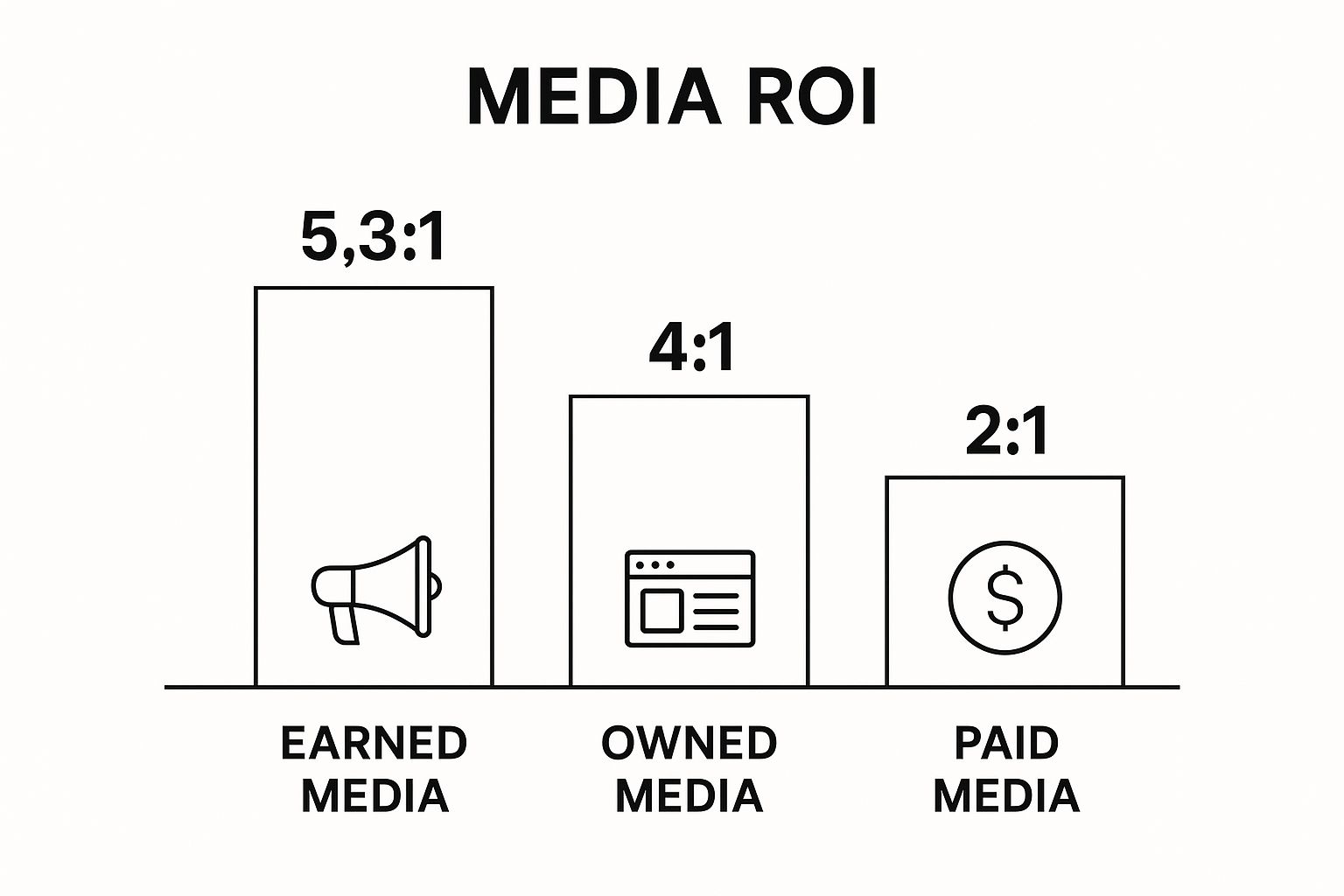
How To Get Press Coverage: Your Complete UK Success Guide
Decoding The UK Media Landscape That Actually Matters
Getting press coverage in the UK isn't about making the most noise. It's about truly understanding the subtle details of the media landscape. It's about knowing which outlets truly connect with your target audience and which publications consistently deliver strong results. This requires a strategic, considered approach—one that goes beyond simply distributing press releases and hoping for the best.
Identifying Key Players in the UK Media
The UK media landscape is diverse, encompassing everything from well-established newspapers like The Guardian and The Daily Telegraph to rapidly expanding digital platforms. Identifying the right outlets for your story is absolutely essential. This means researching publications that align with your target audience and getting to grips with their editorial focus.
For example, if you’re aiming to reach a business audience, publications like the Financial Times or City A.M. would be a better fit than a lifestyle magazine.
Historically, a few powerful conglomerates have shaped the UK media. News Corp, owned by Lachlan Murdoch, controls outlets like The Times, influencing how press coverage is distributed and accessed. Explore this topic further. This concentrated ownership highlights the need to understand the dynamics of individual publications within these larger media groups.
Understanding the Power of Earned Media
While paid and owned media have their roles, earned media—the coverage you organically attract—offers incredible credibility and reach. The infographic below visualizes the return on investment (ROI) for different media types, comparing earned, owned, and paid channels.

As the infographic clearly shows, earned media has a significantly higher ROI of 5.3:1 compared to owned media at 4:1 and paid media at 2:1. This emphasizes the significant value of positive press coverage and reinforces its potential to drive real results for your business. This translates to £5.30 returned for every pound invested in securing earned media coverage.
Navigating the Digital Shift
The decline of traditional print media and the rise of digital platforms bring both obstacles and advantages for those seeking press coverage. While print publications still hold sway, grasping the increasing significance of online news and social media is crucial.
Furthermore, recognizing the unique aspects of each platform, including audience demographics and preferred content formats, will bolster your chances of success. This involves carefully tailoring your pitches and content to match the specific requirements of each individual outlet.
To understand the nuances of the digital media landscape in the UK, consider this comparison of major outlets:
The table below, "Major UK Media Outlets Comparison," offers a concise overview of some key UK publications, highlighting their focus areas, readership demographics, and preferred story types. This information can be invaluable when shaping your media outreach strategy.
| Publication | Audience Size | Primary Focus | Story Preference | Contact Method |
|---|---|---|---|---|
| The Guardian | Large | News, Politics, Culture | In-depth analysis, investigative journalism | Email, Social Media |
| The Daily Telegraph | Large | News, Politics, Business | Conservative viewpoint, breaking news | Email, Phone |
| Financial Times | Medium | Business, Finance | Economic analysis, company profiles | Email, Social Media |
| City A.M. | Medium | Business, Finance | London-focused business news | Email, Phone |
| BBC News Online | Large | News, Current Affairs | Breaking news, impartial reporting | Email, Social Media |
Key takeaways from this comparison include the variation in audience size and focus, highlighting the importance of selecting outlets relevant to your specific message. The table also demonstrates different methods for contacting journalists, emphasizing the need for a tailored approach to media outreach.
Analysing the Competition
Examining your competitors’ media coverage provides useful information on winning strategies. This analysis can help you pinpoint relevant journalists, understand the kinds of stories that resonate, and refine your own approach to securing valuable press coverage.
By learning from your competitors' successes and failures, you can increase your chances of standing out in the competitive media environment. This research can significantly inform your pitching strategy and help you create compelling narratives that attract media attention.
The Truth About What Journalists Face Every Day

Most PR guides overlook a vital aspect of securing media coverage: understanding the realities of today's journalists. Knowing the daily pressures they face is key to getting your story noticed. Let's explore these challenges, from shrinking newsrooms to tight deadlines that heavily influence story selection.
The Resource Crunch and Its Impact on Coverage
Journalists work under immense pressure. They often juggle multiple roles and cover diverse topics with limited resources. This means many worthwhile stories go untold. This resource crunch also affects the kinds of stories prioritized.
Imagine a journalist choosing between a complex investigation and a readily available, easy-to-publish story. Faced with a looming deadline, the simpler option often wins. This isn't due to laziness but rather practicality.
Securing press coverage, particularly in the UK, is becoming increasingly difficult. The 2025 State of the Media Report highlights the growing limitations on journalists' time and resources, resulting in fewer stories covered by reputable outlets. Almost half of the journalists surveyed reported receiving pitches they couldn't pursue due to resource constraints. Find more detailed statistics here. This reinforces the need for focused and valuable pitches.
You might be interested in: How to master public relations.
Making a Journalist's Job Easier, Not Harder
So, how can you become a helpful resource for journalists? First, understand their world. Research their past work and identify their areas of expertise. Don't send generic pitches; tailor your message and show you've done your homework.
The Power of the Pre-Packaged Story
Second, offer a ready-made story, or at least most of the components. Provide clear, concise information, high-quality visuals, and easily verifiable facts. Be a solutions provider, offering not just an idea but the building blocks for a complete article. This dramatically increases your chances of coverage. This approach recognizes journalists’ time constraints and positions you as a valuable asset.
Building Mutually Beneficial Relationships
Finally, concentrate on fostering long-term relationships, not just one-off placements. This provides a significant advantage. Offer valuable insights and expertise even when you're not pitching. Become a go-to source for commentary, providing informed perspectives on industry trends. This builds trust and credibility, making you a valued partner.
By understanding and addressing the challenges journalists face, you can significantly improve your chances of media coverage and develop strong relationships with key media contacts.
Building Stories That Journalists Can't Ignore

Want to see your business featured in the press? It's time to shift from simple announcements to captivating storytelling. This section explores the heart of newsworthy content by looking at what makes successful campaigns tick. We'll uncover the exciting narratives within your business and transform ordinary updates into compelling must-reads.
Identifying the Hook: What Makes a Story Newsworthy?
Great press coverage begins with a powerful hook. This is what grabs a journalist's attention and sparks their curiosity. It's the reason your story rises above the noise. A unique perspective, a timely event, or a human-interest angle can all serve as compelling hooks.
A new product launch is an announcement. Framing it as the solution to a problem faced by consumers? That’s a story. Consider what makes your business relevant to a larger audience. Does it tap into a current trend? Does it have an impact on the local community?
From Routine Updates to Compelling Narratives
Look at the everyday happenings in your business with fresh eyes. A new hire becomes a story about growth and job creation in the UK. A company milestone reflects evolving industry trends. Find the human element, the impact, and the broader significance.
Anatomy of a Memorable Story
Studying successful coverage reveals what truly resonates. Timing is crucial. A story about sustainable practices will likely gain traction during a national discussion about environmental issues. Relevance matters too. A local business initiative will resonate more with a regional UK newspaper than a national one.
Human interest is paramount. Does your story feature individuals overcoming obstacles, achieving something extraordinary, or contributing to their community? These are the stories that truly connect.
Conducting a News Audit: Unveiling Hidden Opportunities
Many businesses miss potential stories hidden within their own walls. A news audit can unearth these hidden gems. Examine every facet of your business: product development, customer interactions, employee achievements, and community involvement.
Are you working on innovative projects? Have you overcome significant challenges? Has positive customer feedback highlighted the impact of your work? Document these and explore how to shape them into captivating narratives.
Packaging Your Story: Making it Easy for Journalists
Present information clearly and concisely. Think like a journalist. Provide them with everything they need: clear information, compelling quotes, high-quality images, and relevant data.
Tailor your approach to the specific publication and journalist. A tech publication will be interested in different aspects than a business publication. This demonstrates respect for their time and understanding of their audience.
Crafting compelling stories that resonate with journalists is the key to unlocking press coverage. It’s not about spin; it's about uncovering and showcasing the authentic narratives that deserve to be shared. This approach will distinguish you from the competition and boost your chances of being featured in leading UK publications.
Using Social Media To Get On Journalists' Radar
Social media has changed how journalists discover sources and develop their stories. Many haven't yet adapted to this new landscape. This section explores effective ways to connect with media professionals online and present yourself as a reliable source. It’s not about constant posting, but about meaningful engagement and building real relationships.
Engaging Meaningfully With Journalists on Social Media
Platforms like X (formerly Twitter), LinkedIn, and Instagram provide direct access to journalists. Engage thoughtfully with their content. Share their articles, offer insightful comments, and participate in relevant discussions they start. This demonstrates your genuine interest and positions you as a knowledgeable voice.
Read also: How to master social media in PR
Sharing Compelling Content That Attracts Attention
Don't just promote your own news; curate and share valuable industry-related content. This showcases your expertise and keeps you top-of-mind for journalists following those topics. Position yourself as a go-to resource, providing relevant and insightful information. This strengthens your credibility.
For example, if you're in FinTech, share articles about emerging trends, insightful analyses, or relevant news from reputable sources. This establishes you as a thought leader and adds value to the conversation. Staying informed about current financial and tech news is key, especially in the UK.
The Power of Social Media in the UK
Consider the significant role social media plays in the UK. 54.8 million people in the UK use social media – approximately 79% of the population. X alone boasts 22.9 million UK users. The UK's social media advertising market is projected to reach £9.95 billion by 2025. This highlights the vast potential for connecting with journalists through these platforms.
Discover more insights about UK digital media consumption
Crafting Compelling Narratives
Journalists constantly seek captivating stories. Create shareable content that showcases your expertise and highlights compelling narratives within your industry. Consider what resonates: human interest, impactful data, or a unique perspective.
Building Relationships, Not Just Visibility
Consistency matters on social media, but avoid overwhelming journalists with self-promotion. Prioritize providing value, engaging genuinely, and respecting their time. Remember, building relationships is the ultimate goal.
- Monitor trending topics: Contribute thoughtfully to relevant discussions. This shows you’re engaged and inserts your expertise into conversations journalists are already following.
- Create visually appealing content: Use images, infographics, and short videos to make your content more shareable.
- Engage actively: Respond to comments, participate in discussions, and build genuine connections. This fosters community and builds trust.
- Be patient: Building meaningful relationships takes time. Focus on consistently providing value, and the connections will naturally develop.
By strategically using social media, you can effectively get on journalists’ radar, build valuable relationships, and significantly increase your chances of earning media coverage.
Building Real Relationships With The Right Journalists

Securing press coverage isn't about blasting out generic press releases. It's about cultivating genuine connections with journalists who cover your specific industry. This means understanding their interests, respecting their time, and offering value that goes beyond a simple pitch. This section offers a guide to identifying, engaging, and building lasting relationships with the journalists who can truly amplify your message.
Identifying the Right Media Contacts
Begin with thorough research. Ask yourself: who is writing about topics relevant to your business? Use tools like Google News and industry-specific publications to pinpoint journalists covering similar beats. Examine their previous work. What angles do they typically pursue? What kinds of stories do they tell?
Understanding a journalist's interests allows you to tailor your pitch, demonstrating that you've done your homework. It also helps you determine if your story aligns with their audience. This focused approach significantly increases your chances of a successful connection.
Providing Value Beyond the Pitch
Adopt a long-term perspective. Ask yourself how you can become a valuable resource for journalists, even when you're not actively pitching a story. Offer expert commentary on industry trends. Share data-driven insights. Connect them with other relevant sources. Becoming a go-to expert builds trust and positions you as a credible voice within your industry.
This demonstrates a commitment to providing genuine value, rather than simply seeking media coverage. You become a collaborator, not just a promoter. For instance, if a journalist regularly covers cybersecurity, sharing relevant research or connecting them with a leading expert in the field can fortify your relationship.
The Do's and Don'ts of Journalist Outreach
When reaching out, personalize your message. Show you understand their beat and articulate why your story resonates with their audience. Keep your communication concise and respect their time. Don't bombard them with follow-ups, but a polite check-in is perfectly acceptable.
- Do: Research the journalist's previous work.
- Do: Tailor your pitch to their interests.
- Do: Offer exclusive insights or data.
- Don't: Send generic press releases.
- Don't: Overwhelm them with follow-up emails.
- Don't: Make unrealistic promises.
These practices demonstrate professionalism and respect, which are fundamental to building strong relationships with journalists. Nurturing these relationships is crucial for effective press coverage.
Handling Rejection Gracefully
Not every pitch will be a success. Rejection is a natural part of the process. Handle it professionally. Thank the journalist for their time and consider asking for feedback. This shows maturity and a willingness to learn. Maintaining a positive attitude, even when faced with rejection, keeps the door open for future opportunities.
Staying on Their Radar (Without Being Pushy)
Consistent, thoughtful engagement is essential. Share their articles on social media. Comment thoughtfully on their posts. Offer helpful resources or insights related to their beat. Maintain visibility without being intrusive. The goal is to nurture an ongoing relationship, not just secure a single placement. This type of engagement requires a nuanced and authentic approach.
Building strong media relationships is a marathon, not a sprint. By offering consistent value and respecting journalists’ time, you'll cultivate a network of media contacts who genuinely value your contributions.
Crafting Pitches That Get Opened and Acted Upon
Your pitch is your first impression, and often your only impression, so it has to be exceptional. This section breaks down the elements of a truly compelling pitch, using examples of real-world pitches that have successfully landed coverage. We’ll cover how to write subject lines that practically guarantee opens, create engaging body copy, and tailor your pitch to specific journalists and publications.
The Subject Line: Your First (and Possibly Last) Impression
A journalist's inbox is overflowing. Your subject line is your first, and possibly last, chance to stand out. It needs to be concise, intriguing, and instantly communicate value. Think of it like a newspaper headline—drawing the reader in to learn more. Generic subject lines like "Press Release" simply won’t cut it. Instead, focus on the most compelling aspect of your story. "Local Musician Launches Innovative Music Education Program," for example, is far more engaging than "Musician Announces New Project."
Body Copy: Telling Your Story Concisely and Effectively
Once your subject line has earned an open, your body copy needs to deliver. Keep it brief and focused on the essential information: who, what, when, where, and why. Journalists are busy, so respect their time by getting straight to the point. Your pitch is a concise and persuasive argument. Highlight the value of your story and why it's relevant to their audience. Start strong, summarizing the key takeaways, then follow up with supporting details and a clear call to action.
Tailoring Your Pitch: Understanding Your Audience
Every journalist is different. Just as you tailor your message to different customers, you must do the same for journalists. Research their previous work and understand their interests. Adapt your pitch to demonstrate you’ve done your homework. Pitching a tech story to a music journalist is unproductive for everyone involved. Personalization shows you value their time and expertise, significantly increasing your chance of coverage. For further insights into press release formatting, check out this helpful resource: How to master press release format.
Timing and Follow-Up: The Art of Persistence Without Pestering
When you send your pitch is just as important as what you send. Avoid Mondays (overflowing inboxes) and Fridays (waning attention). Aim for mid-week, typically Tuesday through Thursday. If you haven’t heard back within a week, a single follow-up is acceptable. Excessive follow-up is counterproductive and can damage your reputation. Professionalism and respect for their time go a long way.
Common Pitching Mistakes to Avoid
Certain errors will almost guarantee your pitch lands in the trash. Avoid hype and exaggeration. Never send generic, mass-mailed pitches. And always double-check for typos and grammatical errors. These simple mistakes undermine your credibility. Attention to detail reflects well on you and dramatically improves your chances of success.
Frameworks for Effective Pitching
To help you craft compelling pitches, consider this simple framework:
- The Hook: Grab their attention immediately with the most compelling aspect of your story.
- The Context: Provide background information and explain the story's significance.
- The Offer: What are you offering the journalist? An interview? Exclusive data?
- The Call to Action: Be clear about what you want the journalist to do.
This structure helps ensure clarity and allows the journalist to quickly assess the value of your story.
To further illustrate effective pitching strategies, let's analyze the factors that contribute to pitch success:
To help illustrate the impact of crafting effective pitches, the following table showcases how specific pitch elements can influence journalist response and coverage outcomes:
Pitch Success Factors Analysis
| Pitch Element | Response Rate Increase | Coverage Success Rate | Best Practice |
|---|---|---|---|
| Compelling Subject Line | Up to 50% | Up to 25% | Highlight the most newsworthy aspect of your story. |
| Personalized Content | Up to 30% | Up to 15% | Tailor the pitch to the journalist's interests and publication. |
| Concise and Clear Writing | Up to 20% | Up to 10% | Get straight to the point and respect the journalist's time. |
| Strong Call to Action | Up to 15% | Up to 5% | Clearly state what you want the journalist to do. |
This data demonstrates how a well-crafted pitch can significantly improve your chances of getting your story noticed and covered. By focusing on these key elements, you can create pitches that resonate with journalists and ultimately lead to greater media success.
Maximising Every Piece Of Coverage You Secure
Getting press coverage is a fantastic achievement, but it's only the first step. The real magic happens when you amplify that coverage, transforming it into a wealth of opportunities. Let's explore how to maximize your press wins, turning one piece of coverage into a ripple effect of positive media attention.
Amplifying Your Message Across All Channels
Think of your press coverage as a spark. Share it everywhere! Your website, social media channels like Instagram and X, email newsletters, and even internal communications. Don’t just link to the article. Pull out compelling quotes and key takeaways. Create eye-catching graphics with positive quotes and share them visually. This reinforces your core message and broadens your reach. It’s like giving a glowing testimonial a megaphone, amplifying its impact and reaching new ears.
Building Momentum: Using Initial Coverage to Secure More
One piece of coverage can unlock so many other doors. Use your initial success as a springboard when pitching to other publications. Mentioning a recent feature in a respected publication like The Guardian adds instant credibility to your pitch, even to smaller, niche publications. It creates a snowball effect, building momentum and generating even greater impact.
Measuring True Impact: Beyond Reach and Circulation
Measuring the true effectiveness of your press coverage goes beyond simple metrics. Reach and circulation are important, but consider the qualitative impact. Did the coverage boost website traffic? Did social media engagement spike? Did sales inquiries increase? These are the tangible results that demonstrate the real-world value of your PR efforts. Also, track brand mentions and sentiment analysis across social media to gauge how public perception shifts.
Maintaining Relationships for Ongoing Opportunities
The relationships you build with journalists are invaluable. Express your gratitude for their coverage and keep them in the loop about your future endeavors. Offer them exclusive insights or early access to upcoming news. Nurturing these relationships positions you as a trusted source and paves the way for future coverage.
Turning Positive Coverage Into Long-Term Opportunities
Positive press coverage isn't a fleeting moment; it's a valuable asset. Repurpose the content! Turn it into blog posts, case studies, or engaging social media updates. Weave quotes from the article into your marketing materials and website copy. This creates a continuous cycle of positive reinforcement, strengthening your brand reputation and establishing you as a thought leader in your industry. This consistent messaging solidifies your position as an industry authority. Ready to elevate your brand's presence in the UK media landscape? Blackbird Digital, a leading marketing agency specializing in digital PR and SEO, helps businesses secure coverage in top-tier publications like the BBC, Bloomberg, Forbes, and Daily Mail. Learn more about how Blackbird Digital can help you achieve your PR goals.




